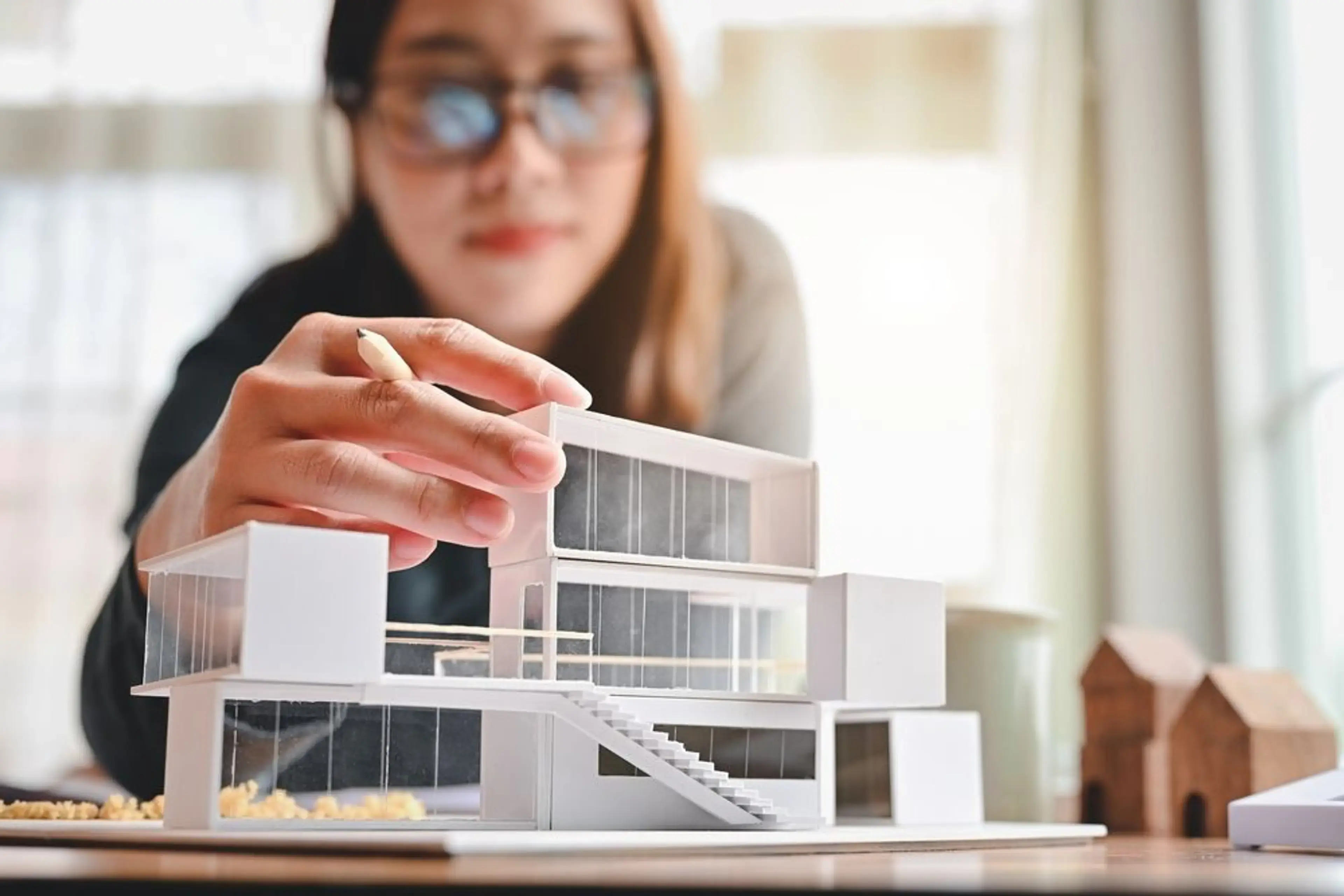Architect Design Styles to Follow in the Coming Future
Architect Design Styles to Follow in the Coming Future
Blog Article
Understanding the Diverse Job Paths Available for Aspiring Architect
As an ambitious Architect, you have a world of job paths waiting on you. Each course provides one-of-a-kind challenges and chances to use your imagination and technological know-how. Whether you're drawn to standard architecture or the nuances of lasting layout, there's a specific niche that straightens with your interests. Comprehending these varied options can shape your expert trip, but which direction will you select to discover first?
Conventional Design: Creating Structures and Frameworks
Typical style concentrates on creating structures and frameworks that mix functionality with aesthetic appeal. As you explore this field, you'll appreciate the intricate balance between form and purpose. You'll learn to draw inspiration from historic designs, including components like proportion, products, and craftsmanship. Your styles can reflect cultural heritage, showcasing local traditions while fulfilling modern-day demands.
You'll develop skills in composing, model-making, and website analysis, allowing you to envision and interact your ideas effectively. Involving with clients, you'll need to recognize their vision and equate it into feasible styles.
Additionally, building codes and sustainability techniques are crucial in your work, ensuring your frameworks are risk-free and eco friendly. As you expand in your profession, you'll find possibilities in domestic, commercial, or even repair projects, each offering one-of-a-kind difficulties. Embracing standard architecture leads the way for a meeting profession that pays tribute to the past while shaping the future.
Urban Preparation: Shaping Areas and Public Spaces
As an aspiring Architect, you can play a vital role as a metropolitan organizer, transforming just how communities engage and operate. By utilizing area engagement methods, you'll guarantee that locals have a voice fit their environment. Plus, incorporating lasting design principles will certainly assist create areas that not just fulfill today's needs however additionally safeguard the future.
Function of Urban Planners
While many could assume of designers as the sole enthusiasts behind buildings, urban planners play an important role in forming the more comprehensive landscape of neighborhoods and public areas. By working together with various stakeholders, you'll aid make parks, transport systems, and property areas that promote social interaction and availability. Your know-how in spatial style and neighborhood dynamics permits you to picture future development while protecting social heritage.
Area Interaction Strategies
Effective area involvement techniques are vital for urban organizers to ensure that the voices of locals are heard and valued in the preparation procedure. To foster meaningful discussion, you should prioritize open forums and workshops where neighborhood members can reveal their concepts and issues. Usage surveys and social media sites to get to a broader audience, making certain diverse point of views are included. Working together with neighborhood organizations can improve trust and assist in much deeper connections. It is very important to provide clear info concerning decision-making procedures and suggested projects, enabling homeowners to feel educated and encouraged. By actively listening and integrating comments, you'll develop spaces that reflect the neighborhood's demands, ultimately bring about more successful and sustainable urban atmospheres. Embrace transparency and continuous dialogue for enduring influence.
Lasting Design Concepts
When designing city areas, incorporating lasting design concepts is important for creating settings that flourish both environmentally and socially. Think about integrating environment-friendly spaces, like parks and gardens, to enhance biodiversity and enhance air quality.
Designing with water preservation in mind is likewise key-- think of rainfall yards and permeable surface areas to manage stormwater. Including community participants throughout the planning process assurances that the areas you create satisfy their needs and motivate social interaction. By embracing these principles, you'll add to lively, lasting metropolitan landscapes that profit everybody.

Landscape Architecture: Developing Lasting Outdoor Settings
As you check out landscape style, you'll uncover vital style principles that develop stunning and functional exterior spaces. Lasting practices play a vital function in ensuring these atmospheres thrive while lessening environmental effect. And also, you'll discover a selection of career possibilities that allow you to make a real distinction in how individuals interact with nature.
Design Principles in Landscape
Recognizing layout concepts in landscape architecture is crucial for producing lasting outdoor atmospheres that integrate with nature. You'll need to consider components like equilibrium, scale, and proportion to assure your layouts really feel cohesive and welcoming. Integrating indigenous plants not just boosts biodiversity but likewise minimizes water use, making your landscape resilient. Think of the flow of room and just how people engage with it; pathways and seating areas ought to welcome exploration and relaxation. In addition, take notice of seasonal changes, making with products that complement the surroundings year-round (Architect). By prioritizing sustainability and aesthetics, you can produce outside areas that enhance the neighborhood and promote wellness. Accepting these principles will establish a solid foundation for your career in landscape style.
Sustainable Practices Overview
Sustainable methods in landscape architecture not only concentrate on looks yet likewise focus on environmental wellness and source conservation. By integrating indigenous plants, you improve biodiversity and minimize the need for chemical plant foods and pesticides. Executing reliable irrigation systems helps save water and minimizes drainage, safeguarding neighboring environments. You can design rooms that promote dirt health, such as making use of organic products and practicing permaculture principles. Furthermore, incorporating eco-friendly framework, like rain yards and porous pavements, help in stormwater management and minimizes urban warm. You contribute to a much healthier planet and offer rooms that this link cultivate community connection when you develop exterior environments with sustainability in mind. Eventually, these techniques ensure your styles profit both people and the atmosphere for several years ahead.
Job Opportunities Expedition
With a strong structure in sustainable techniques, landscape design offers a selection of profession paths that permit you to make a significant impact on the setting. Urban coordinators often work together with landscape architects to produce green spaces in city settings, boosting city livability. If you're passionate about education and learning, consider becoming a landscape design teacher, inspiring future generations.
Lasting Layout: Concentrating On Eco-Friendly Practices
As you discover your occupation in design, embracing green methods can establish you apart in a competitive field. Lasting design concentrates on developing buildings that reduce ecological influence while enhancing passenger health. By incorporating sustainable products, energy-efficient systems, and lasting structure techniques, you'll contribute to a greener future.
Beginning by obtaining knowledge of eco-friendly qualifications like LEED or BREEAM, which can bolster your credentials. Think about just how natural light, ventilation, and thermal effectiveness can maximize layout. Team up with engineers and environmental specialists to innovate services that minimize waste and preserve sources.
Do not neglect the relevance of community involvement-- engaging local stakeholders can inspire designs that harmonize with the environment. As clients increasingly prioritize sustainability, your experience in eco-friendly practices will not only attract projects but also fulfill your passion for liable style. Welcome this critical facet of the career, and see your career flourish.
Historical Preservation: Shielding and Recovering Social Heritage
While you begin on your architectural journey, take into consideration the crucial function of historic preservation in keeping our social heritage. This field concentrates on the defense and repair of significant structures, websites, and structures that tell the tales of our past. By participating in historical conservation, you'll assist secure the building legacy that forms neighborhood identity.
As a historic conservation Architect, you'll examine historical relevance and evaluate the problem of structures. You'll function very closely with guardians and chroniclers to ensure genuine remediation strategies are employed. This occupation path enables you to mix creativity with study, enabling you to create solutions that appreciate initial materials and workmanship.
Your job not only adds to sustainability by recycling existing buildings however additionally fosters a feeling of satisfaction within communities. Welcoming this path will aid you become a guardian of history, protecting the tales and aesthetics that enhance our lives.
Inside Style: Enhancing Indoor Spaces
Historical preservation and interior design both share a dedication have a peek at this website to boosting the constructed environment, but they concentrate on different elements. While historical conservation stresses keeping a framework's historical and cultural value, interior design nos in on enhancing interior areas for performance and appearances.
As an aspiring Architect, you'll find that interior architecture allows you to mix creativity with technological abilities. You'll make rooms that not just look excellent yet also promote comfort and performance. This area entails understanding just how light, shade, and products engage within an area, impacting mood and usability.
You'll work on various tasks, from household homes to business offices, making certain that each setting satisfies the requirements of its residents. By prioritizing customer experience, you can change interiors into motivating and useful rooms, making a substantial effect on exactly how people interact with their environments. Accept the opportunity to boost interior environments and form the means people live and work.
Industrial Style: Merging Capability With Visual Appeals
Commercial layout plays a crucial duty in developing products that perfectly blend aesthetics with functionality, guaranteeing that what you use day-to-day is not just visually enticing however also practical. As an ambitious Architect, you could involve on your own in this field, concentrating on creating whatever from furniture to customer electronic devices. Your work includes understanding individual demands, materials, and making procedures, enabling you to develop innovative remedies that enhance daily experiences.
In commercial style, you'll commonly work together with manufacturers, designers, and marketing experts, making sure that your styles are not only next page beautiful yet likewise possible. This career course uses a dynamic setting where imagination meets usefulness, making it a satisfying choice for engineers interested in shaping the items of tomorrow.
Often Asked Questions
What Educational Certifications Do I Need to Become a Designer?
To become an engineer, you'll need a specialist degree in style, normally a Bachelor's or Master's. Furthermore, you'll need to complete a teaching fellowship and pass the Architect Enrollment Examination to exercise legally.
Are There Qualification Demands for Different Building Job Paths?
Yes, there're accreditation needs for various building paths. Architect. You'll require to pass exams, total internships, and often go after specialized training, depending on your selected emphasis, like landscape style, metropolitan layout, or historical preservation
What Software Program Abilities Are Vital for Engineers Today?

How Can I Gain Practical Experience While Researching Architecture?
You can obtain functional experience by interning at architectural companies, joining layout competitions, offering for area jobs, or teaming up with schoolmates on real-world assignments. These chances enhance your abilities and build useful connections in the market.
What Job Opportunities Exist Outside Typical Architecture Firms?
You can check out numerous job possibilities outside traditional design companies, like urban planning, indoor style, landscape style, construction administration, realty growth, and even functions in sustainability consulting. Each deals special obstacles and rewards.
Whether you're drawn to traditional design or the subtleties of lasting layout, there's a niche that lines up with your rate of interests.When making city rooms, incorporating sustainable design principles is essential for producing atmospheres that prosper both environmentally and socially.As you check out landscape design, you'll discover important design concepts that produce functional and gorgeous outdoor spaces.Understanding design concepts in landscape style is crucial for developing lasting outside settings that harmonize with nature.In industrial style, you'll typically team up with designers, marketing professionals, and manufacturers, ensuring that your layouts are not only gorgeous but additionally possible.
Report this page